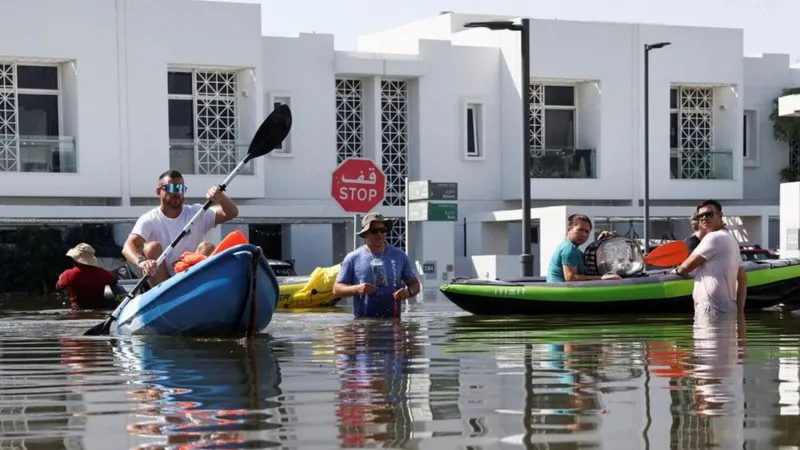How climate change worsens heatwaves, droughts, wildfires and floods
More than 70 million people in the US are under heat alerts this week, with extreme temperatures as high as 105F (41C) forecast in some areas.

Scientists say many extreme weather events are becoming more frequent and intense as a result of climate change.
1. More extreme rain
For every 1C rise in average temperature, the atmosphere can hold about 7% more moisture.
This can result in more droplets and heavier rainfall, sometimes in a shorter space of time and over a smaller area.
1) More heat from sun causes greater evaporation 2) More moisture forms clouds 3) Heavier rain
Globally, heavy rainfall events have become more frequent and intense over most land regions due to human activity, according to the UN's climate body, the IPCC.
It says this pattern will continue with further warming.
Scientists assess whether individual extreme weather events can be attributed to climate change by considering both natural and human causes.
In the case of the intense rainfall which fell in Dubai, the United Arab Emirates (UAE) and Oman in April 2024, it was difficult to conclude exactly how much of a role climate change played.
Heavy rain in this region is rare, which offers researchers fewer historical comparisons.
But these types of events have become 10-40% heavier, and climate change is the most likely explanation, according to the World Weather Attribution (WWA) group.
In May 2024, southern Brazil experienced heavy rains which lead to widespread flooding, displacing about 150,000 people.
The Rio Grande do Sul region that was hit is particularly vulnerable to heavy rains, as it is the meeting point of tropical and polar air masses.
But climate expert Francisco Eliseu Aquino told the AFP news agency that "these interactions [have] intensified with climate change".
The mayor of Derna in northern Libya suggested as many as 20,000 may have been killed as a result of the flooding
Scientists believe the heavy rainfall which caused deadly flooding in northern Libya in September 2023 was made up to 50 times more likely by climate change.
Years of political instability in the region also hampered preparations for such events.
2. Hotter, longer heatwaves
Even a small increase in average temperatures makes a big difference to heat extremes.
As the range of daily temperatures shifts to warmer levels, hotter days are more likely and more intense.
"A small shift makes a big difference". A line chart showing how small changes in the climate increases the probability of more hot weather and more extreme weather.
In April 2024, temperatures in Mali hit 48.5C during an extreme heatwave across the Sahel region of Africa, which was linked to increased hospitalisations and deaths.
This level of heat would not have been possible without human-caused climate change, the WWA found, and will become more common as the world continues to warm.
In the UK, temperatures topped 40C for the first time on record in July 2022, causing extensive disruption. This would have been extremely unlikely without climate change, the WWA says.
Heatwaves are also becoming longer in many places, including the UK.
This can happen as a result of heat domes, which are areas of high pressure where hot air is pushed down and trapped, causing temperatures to soar over large areas.
1) A mass of warm air builds up in still and dry summer conditions 2) High pressure in the atmosphere pressures the warm air down 3) The air is compressed and gets even hotter
One theory suggests that higher temperatures in the Arctic - which has warmed nearly four times faster than the global average - are causing strong winds called the jet stream to slow, increasing the likelihood of heat domes.
A heat dome is expected to hit the western part of the US later this week - affecting more than 34 million residents across California, Nevada, Utah and Arizona.
Forecasters predict temperatures to be 5.5-11C (10-20F) above normal, potentially posing a risk to human health and the environment from resulting wildfires.
3. Longer droughts
Linking climate change with specific individual droughts can be difficult.
The availability of water depends on more than just temperature and rainfall, with natural weather systems also playing a key role. This was the case with drought in southern Africa in early 2024.
But heatwaves fuelled by climate change can worsen droughts by drying out soil. This makes the air above warm up more quickly, leading to more intense heat.
During periods of hot weather, increased demand for water, especially from farmers, puts even more stress on the water supply.
In parts of East Africa, there were five failed rainy seasons in a row between 2020 and 2022, as the region suffered its worst drought for 40 years. This displaced 1.2 million people in Somalia alone.
Climate change has made droughts like this at least 100 times more likely, according to the WWA.
Human-caused warming was also the main driver of the Amazon rainforest's worst drought in at least half a century in the second half of 2023.
Map of drought intensity across South America. Much of the Amazon basin experienced the most intense levels of drought, marked in oranges and reds.
4. More fuel for wildfires
Fires happen naturally in many parts of the world. It's difficult to know if climate change has caused or worsened a specific wildfire because other factors are also relevant, such as changing land use.
But climate change is making the weather conditions needed for wildfires to spread more likely, the IPCC says.
Extreme, long-lasting heat draws more moisture out of soils and vegetation.
These tinder-dry conditions provide fuel for fires, which can spread at an incredible speed, particularly if winds are strong.
Canada experienced by far its its worst wildfire season on record in 2023.
Canada experienced by far its worst wildfire year on record in 2023
Climate change more than doubled the likelihood of the extreme "fire weather" conditions in eastern Canada in May and June 2023, which helped fires to spread, the WWA says.
Rising temperatures may also increase the likelihood of lightning in the world's northernmost forests, triggering fires.
The combined effects of shifting land use and climate change mean extreme wildfires are projected to become more frequent and intense in future globally, according to the UN Environment Programme (UNEP).
The number of the most extreme fires may rise by up to 50% by 2100, UNEP suggests.
-bbc






